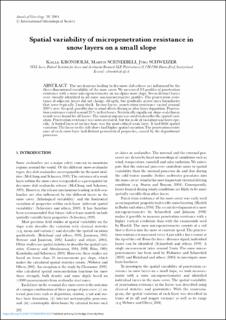| dc.description.abstract | The mechanisms leading to dry-snow slab release are influenced by the three-dimensional variability of the snow cover. We measured 113 profiles of penetration resistance with a snow micropenetrometer on an alpine snow slope. Seven distinct layers were visually identified in all snow micropenetrometer profiles. The penetration resistance of adjacent layers did not change abruptly, but gradually across layer boundaries that were typically 2 mm thick. In two layers, penetration resistance varied around 200% over the grid, possibly due to wind effects during or after layer deposition. Penetration resistance varied around 25%in five layers. Statistically significant slope-scale linear trends were found for all layers. The semivariogram was used to describe the spatial variation. Penetration resistance was autocorrelated, but the scale of variation was layer-specific. A buried layer of surface hoar was the most critical weak layer. It had little spatial variation. The layers in the slab above had higher spatial variation. The penetration resistance of each snow layer had distinct geostatistical properties, caused by the depositional processes. | en_US |
